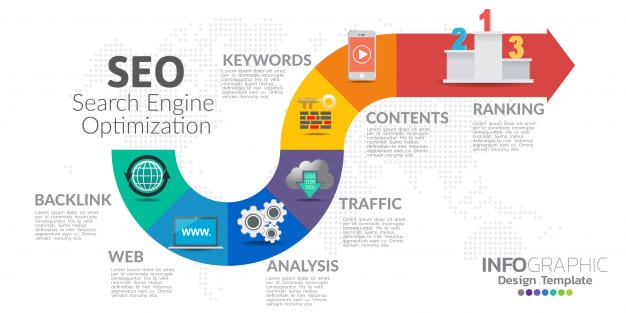
Are you looking to rank your website higher in the search engine results pages (SERPs) but are having trouble knowing where to start? Follow these simple tips, and you should start shooting up the rankings, so you can get more visitors to your site.
Ways to Boost Your Website Ranking
Improving your website ranking is a goal that can be reached in several ways via multiple avenues. As such, we have come up with a list of tips to help you reach that first page of the SERPs that cross various departments, such as social media, site performance, content, and more. Start implementing them now, so you can reap the rewards of this multifaceted SEO approach soon.
Use Influencer Marketing on Instagram
You can get instant traffic and an eventual ranking boost by teaming up with influencers on Instagram who have massive audiences. Just one post on an influencer’s Instagram page can expand your reach with minimal effort.
Read: Tips to Increase Instagram Engagement
Join Facebook Groups Where Your Visitors May Hang Out
Think of Facebook groups where your readers may join to exchange ideas with others who have similar interests. Then, join those groups yourself, be active in them, and use them to drive traffic to your site, so you can get more visitors and a better ranking.
Read: Tips to Increase Facebook Engagement
Put Your Images on Pinterest
While many tend to use Instagram and Facebook to expand their reach, Pinterest may be your best bet if you have an e-commerce or retail brand. When it comes to referral traffic, Pinterest is king, as Shopify found that it drove 200% and 33% more traffic to shopping sites than Twitter and Facebook, respectively.
Add Social Media Sharing Buttons
Do you want to get more eyes on your posts and website? Then, add social media sharing buttons to your site, as it makes it easier for your visitors to share your content with others.
Check for Broken Links
Having broken links on your site can lead to a poor user experience while damaging your SEO efforts. Some tools make it easy to check for broken links to avoid this faux pas, such as Ahrefs or Google Analytics.
Remove Dead or Unnecessary Code
If you have not been using any tools to detect dead or unnecessary code on your site, now is the time to do so. The more deadweight on your site, the longer it will take for search engines to crawl it. This can result in a slower load time and less-than-ideal search engine rankings.
Read: Best Social Media Optimization Tips
Put Brackets or Parentheses in Some of Your Titles
One of the easiest ways to improve your website ranking and traffic is to use brackets or parentheses in some of your titles. According to one study, titles with brackets saw 33% better performance than those without them.
As for what makes brackets or parentheses so effective, you can credit much of it to the fact that they simply catch the eye and stand out from letters in a title.
Use More Numbers Plus Power Words in Your Titles
You can get a significant boost in your click-through rate by making one simple move: Adding statistics and numbers to your titles. Studies show that posts containing numbers in the titles tend to land higher in the SERPs, which helps them generate a lot more traffic. Two simple ways to ensure you have more numbers in your titles are creating some step-by-step guides or posts featuring lists.
While injecting numbers into your titles can boost you up the SERPs while increasing your click-through rate, so can including power words in your titles. Power words are words like “best” or “proven” that, while seeming innocent, actually have the power to draw visitors in.
Include Your Target Keyword in Your Titles
Placing keywords strategically in your content is still a great SEO practice. Be sure to also include them in your titles, as it is a simple way to get a nice SEO boost. Since headlines are restricted to 65 characters, you will need to make your keyword placement count. So, instead of trying to stuff too much into your headlines, be sure to include your target keyword for the best results.
Read: Essential On-Page SEO Tips
Start Using More Long-tail Keywords
Some people stray from long-tail keywords because their monthly search volume is lower. That is not necessarily a smart move, though, as that lower search volume means less competition.
Another reason to use long-tail keywords in your titles or content to boost your ranking is that they often lead to higher conversions since they tend to line up with user intent. Also, Google is starting to emphasize user intent, so you align yourself with the search engine’s desires by using long-tail keywords.
To improve your long-tail keyword usage, go through your content. Look at each piece and determine what the intent is behind it. Then, look for long-tail keywords that match that intent and inject them into the content.
Put Your Contact Info Somewhere on Your Site
Trustworthiness plays a significant role in Google’s eyes, and one of the simplest ways to build trust is to include your contact info on your site. If it is not there, your visitors will not be able to see it. And more importantly, Google will not be able to see it, which can negatively impact your ranking. Take the time to put your contact info somewhere, so you can get both legitimacy and ranking boosts.
Improve Your Click-through Rates With Keyword-rich Meta Descriptions
Although meta descriptions are not considered official ranking factors, they can have a massive impact on where you land in the SERPs. How? By convincing search engine users to click on your result versus a competitor’s. The more clicks you get, the better your ranking.
To make the most impact with your meta descriptions, take time to ensure they contain unique, exciting copy that coaxes users to click. Also, include the keyword you are targeting for that page, as that can match the user’s search, so you get an almost automatic click.
Make Sure Your Content is Up-to-date
The more relevant your site appears to Google, the better your ranking will be. Regularly updated content can make your site appear more relevant to search engines.
How can you achieve this? An excellent place to start is to use Search Console or Google Analytics to check your most popular URLs. Do some research and add fresh content to those URLs, so they are updated and relevant, and you should be good to go.
Read: SEO Headers: Best Practices and Tips
Make Sure Your Images are in Order
If you have the budget or talent to do so, do everything possible to ensure your images are of the highest quality. It will improve the user experience, which can lower your bounce rate and improve your SEO.
Not only should your images be of high quality, but they should also be working. Broken images, while they may seem unimportant, can increase your bounce rate. One way to ensure your images display as intended is to avoid third-party image hosting.
When image hosting services experience spikes in traffic, it can result in some of your images being blocked or removed.
Skip the Stock Images
While it may be tempting to use stock images on your site since they save time, doing so can negatively impact your SEO. Even worse, it can make your site or brand seem unoriginal, which can make any visitors leave quickly.
Instead of taking the easy route with stock images, hire someone to make original graphics for your site. Or, depending on the content, you can use screenshots, especially if you have posts that are guides where you describe specific steps.
Read more search engine optimization (SEO) and social media management tutorials.



